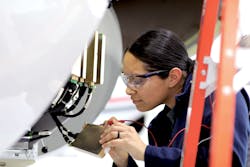From lights to transponders, displays, radios and everything — literally — in between, avionics is the technology behind, or beneath the panels, of flight. And, as the technology and electronics inside our phones and computers trend ever smaller, faster, lighter and stronger, so too does the electronics of today’s aircraft.
Craig Bries, vice president and general manager, avionics service and support for Collins Aerospace agreed it’s the trend. “Collins Aerospace continues to improve and innovate our products, the tenets of these offerings are in increasing product reliability, making our products smaller, lighter, and faster and integrating additional functionality in single systems,” Bries said.
Vamsi Gundluru, senior director of offering management, cockpit systems, of Honeywell Aerospace added that, “the commercial operators always ask for more reliable, cheaper and lighter systems. In the last few years, connectivity and security are increasingly important for commercial operators, as well,” he continued.
Honeywell has a long history of deploying maintenance systems to airplanes, starting in early 90s and Gundluru said in that time they have seen an increase in those system capabilities and aircraft systems coverage; going from being non-existent to being required across the industry and defense sector.
“Initially, the system was focused on simple fault isolation of electronic systems that were starting to be used in airplanes. Today, all the systems onboard an airplane have electronics and software and, all of them communicate with the onboard health management system. As we move forward and technology evolves, we will have access to more information about the systems and there will be more sensors in the aircraft, allowing for better fault isolation. In addition, we have been developing new features for our system, looking at future needs in areas such as urban air mobility,” Gundluru said.
At Collins, Bries said commercial operators demand high-reliability products and also want better technology in terms of the product offering, such as digital communication, high bandwidth, more tightly correlated navigation and traffic applications that allow for condensed operational efficiency. “Minimizing unscheduled removals and spares inventory continue to be areas of focus. Also, predictable maintenance is a must,” he added.
Bries said that some of Collins’ current investments involve improving navigation with their new multimode receiver (MMR) for Global Navigation Satellite System, delivering more integration of function, higher availability and improved navigational performance. The company also continues to update their communication products and are currently developing a better high-frequency radio product, as well as the next generation of Iridium Satellite communication solutions. And within Collins’ vision systems product line, their Enhanced Vision System camera will come to market this year.
“With regard to the new MMR, Collins has been a leader in GNSS solutions for more than 30 years. The VHF Omnidirectional (VOR) function is now embedded in the product, and it is also SBAS LPV compliant, meets all current standards and is software upgradeable to all future standards,” Bries elaborated. “To address customers’ needs for higher data rates, the new communication products deliver a more digital solution with higher communication bandwidth. Our Enhanced Vision System provides lower landing minima by delivering better visual acuity to the pilot in difficult weather and visually-obscure scenarios. It is more aerodynamic and provides more visual spectrum than other products previously in the market.”
Data security, Gundluru said, is one of the main trends that they are seeing in the avionics market. “The main trends we are observing are related to data security, task automation, remote access to the airplane to check status, collect data and send data. Another trend is the ‘electrification’ of mechanical systems, that will have profound influence in aircraft design in the future,” said Gundluru.
Bries added that efficiency continues to be a driving factor. “Customers are very focused on driving efficiency in their operations. The latest announcements have been around moving to more efficient aircraft, reducing turn times, adding inflight efficiencies and removing all barriers that inhibit on-time completion of missions,” he said.
One of the ways that Colins has optimized their system is through maintenance.
“The majority of Collins Aerospace avionics systems have dedicated onboard maintenance systems/functions that provide notifications and alerts when faults or failures occur. These alerts and notifications provide guidance on which system is impacted, and even provide initial fault diagnostics,” said Bries.
In the last few years, Gundluru said that Honeywell, too, has found that security, along with connectivity, are increasingly important for commercial operators, as well as a streamlined maintenance approach. “Specifically talking about the maintenance aspect, it is always desirable to have a fast turnaround time (TAT) with lower maintenance costs, which includes reducing no fault founds (NFF). Access to data, recording data and having improved tools to visualize trends and guide the maintenance crew has also being a common request. Honeywell has invested to improve the system in a way to generate custom reports, record all the bus data and provide off board tools for data visualization, anomaly investigation and trend analysis using machine learning,” Gundluru said.
Looking ahead, Gundluru said that he predicts that the avionics systems of the future will see more consolidation of federated systems and a move to more single-pilot operations, requiring automation of several pilot’s tasks for some cases.
“Streaming data from the airplane is also likely to happen, especially for UAM applications. Customization is also crucial for the future of the avionics systems,” Gundluru added. “An example is the ADT (Autonomous Distress Tracking) that is soon becoming a mandate and several airplanes still do not have a good solution. Honeywell is developing a fully-retrofittable solution using ELT hardware and an updated version of the EGPWS MK V-A. This solution is very flexible and allows for the OEM to create their own trigger conditions that determine distress. As mentioned before, the electrification will make it necessary for the onboard health management system to be able to do diagnostic and prognostic for batteries.”
Bries said that his predictions include: “Increased automation and maximized efficiency. As worldwide traffic grows, our industry must find ways to reduce congestion, improve all weather operations, and minimize maintenance actions. We expect to see increased use of sensor systems to manage automation and reduce crew workload.”
Getting Down to Business
On the business aviation side of the avionics market, Mike Morgan, avionic sales rep at Duncan Aviation in Battle Creek, MI, said the most popular avionics upgrades right now are those that provide connectivity to an aircraft.
“Many operators are using the latest connectivity technologies to equip their aircraft to meet the ever-increasing demand to stay on-line and productive during their travel time,” Morgan said.
Morgan added that for those looking to upgrade their systems, there are three factors to keep in mind: Understand what the needs/requirements of the end users are for the requested system, determine which products are available that meet the needs of the request and seek information from multiple providers to insure the best selection is made based on end user requirements and budget expectations.
Once it comes to the actual upgrading, Morgan said, “Determine if there is a product and certification path for an upgrade on the make and model aircraft to be upgraded, understand if there is a market for the proposed upgrade, secure commitments from the equipment manufacturer and operators to perform the upgrade and after an upgrade is complete and certified produce a marketing campaign to promote future upgrades to ensure program success.”
And, in the near future, Morgan said advancements in air-to-ground connectivity technology will be the avionics upgrade go-to for business planes.
“Advancements in air-to-ground connectivity technology is very close to coming out to the market. It will allow much greater speeds for passengers and crew to have the latest information as they request it. It will allow the in-office experience in their aircraft at a more affordable price point,” he said.
About the Author
Walker Jaroch
Editor
Contact: Walker Jaroch
Editor | AMT
+1-920-568-8399
>> To download the AviationPros media kits, visit: Marketing Resource Center
>>Check out our aviation magazines: Ground Support Worldwide | Airport Business | Aircraft Maintenance Technology

